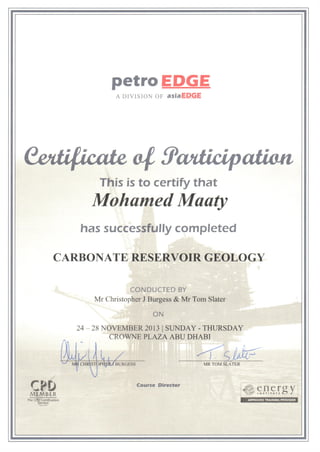1 of 1
Download to read offline

Ad
Recommended
145 swapnil
145 swapnil4th International Conference on Advances in Energy Research (ICAER) 2013
╠²
The document summarizes research on using ionic liquids for extractive desulfurization of liquid fuels. Key points:
1) Ionic liquids show potential as green solvents for removing sulfur from fuels, as an alternative to conventional volatile organic compounds that have environmental and recyclability issues.
2) Experiments examined various imidazolium-based ionic liquids for extracting sulfur compounds like dibenzothiophene from model fuels. Higher removal percentages and partitioning coefficients were achieved at higher temperatures and longer reaction times.
3) Sulfur was more easily removed from fuels using ionic liquids, with reactivity depending on the specific sulfur compound. Spent ionic liquids could be reused multiple times with aCARBONATE RESERVOIR GEOLOGY
CARBONATE RESERVOIR GEOLOGYpetroEDGE
╠²
The document provides an overview of a training course on carbonate reservoir geology, highlighting positive feedback from past participants regarding the quality of the instruction and course content. The five-day course covers essential topics such as carbonate sedimentology, diagenesis, sequence stratigraphy, and reservoir assessment, aimed at petroleum geologists and other professionals in the energy sector. It also includes practical sessions using both personal and extensive non-exclusive data to deepen understanding of carbonate reservoirs.Global Tectonics Evolution: Plate Tectonics: The Oceans Part I
Global Tectonics Evolution: Plate Tectonics: The Oceans Part IWilliam Szary
╠²
The document provides an overview of global plate tectonics, focusing on the evolution of ocean basins, including the Atlantic, Caribbean, Nazca, Cocos plates, and the Mediterranean Sea over various geological periods. It includes a series of paleogeographic maps illustrating tectonic shifts from the late Permian to recent epochs. The material is part of an educational software series by Earth2Energy, emphasizing the dynamic nature of Earth's geology.Thesis - Exploration Phase: Deepwater Carbonate Reservoir Data Integration fo...
Thesis - Exploration Phase: Deepwater Carbonate Reservoir Data Integration fo...Alan M├Čssinger
╠²
This thesis focuses on developing static and dynamic reservoir models and predicting properties for a deepwater carbonate reservoir during the early exploration phase when limited data is available. Core, log, and well test data are integrated and used to characterize the reservoir into hydraulic flow units (HFU). Five HFU are identified and upscaled to populate the static model. Well test analysis estimates permeability-thickness product and permeability with less than 20% error. Dynamic simulations of four static models match well test pressure responses and predict a numerical productivity index within 5% of measured. Simulations of the entire oil zone indicate potential recovery of 25% of original oil in place.Desulfurization
DesulfurizationKareem Tharaa
╠²
The document discusses methods for removing sulfur from crude oil. Sulfur is present as both organic and inorganic compounds in crude oil. The most common removal methods are catalytic desulfurization, chemical desulfurization, physical adsorption of sulfur oxides, and wet sulfuric acid processes. Catalytic desulfurization, also called hydrodesulfurization, uses hydrogen and catalysts at high pressure and temperature to convert sulfur compounds to hydrogen sulfide. Chemical desulfurization methods include treatments with acid chromous chloride or peroxyacetic acid. Physical adsorption uses carbonaceous adsorbents to capture sulfur dioxide from flue gases.Using 3-D Seismic Attributes in Reservoir Characterization
Using 3-D Seismic Attributes in Reservoir Characterizationguest05b785
╠²
The document discusses using 3D seismic attributes for reservoir characterization. It provides an overview of seismic reflection methods and defines seismic attributes as any measurement derived from seismic data. Common types of attributes are described including time, complex trace, window, Fourier and multi-trace attributes. The document gives examples of attributes like envelope, phase, frequency and coherence that can provide information on lithology, thickness, faults and fractures. Methods of interpreting attribute data from 3D volumes are outlined. The document concludes by providing examples of how attributes can be used for reservoir characterization tasks like fault interpretation and porosity estimation.Operational Geology Chart_Saudi Arabia
Operational Geology Chart_Saudi ArabiaMohamed Abouel-Maaty
╠²
This document provides lithological descriptions and drilling recommendations for multiple geological formations in Saudi Arabia. It describes the typical lithologies within each formation such as sandstone, limestone, dolomite and shale. It also provides information on estimated pore pressures, recommended mud weights, potential loss circulation zones and reservoir zones. Casing points are recommended for some formations to protect aquifers or seal off loss circulation zones.South IRAQ Operational Geology Chart
South IRAQ Operational Geology ChartMohamed Abouel-Maaty
╠²
This document provides lithological descriptions and drilling recommendations for various geological formations in South Iraq, from surface to deep formations. It describes each formation's dominant lithology, average thickness, pore pressure, potential drilling problems, and recommended mud weight. Shallower formations like the Dibdiba consist of sand/gravel and limestone, while mid-formations include the carbonate-rich Dammam and deeper gas-bearing formations like the Tayarat and Umm Er Radhuma. Casing points are recommended within productive formations like the Sadi to prevent shallow collapse during drilling.More Related Content
More from Mohamed Abouel-Maaty (6)
Operational Geology Chart_Saudi Arabia
Operational Geology Chart_Saudi ArabiaMohamed Abouel-Maaty
╠²
This document provides lithological descriptions and drilling recommendations for multiple geological formations in Saudi Arabia. It describes the typical lithologies within each formation such as sandstone, limestone, dolomite and shale. It also provides information on estimated pore pressures, recommended mud weights, potential loss circulation zones and reservoir zones. Casing points are recommended for some formations to protect aquifers or seal off loss circulation zones.South IRAQ Operational Geology Chart
South IRAQ Operational Geology ChartMohamed Abouel-Maaty
╠²
This document provides lithological descriptions and drilling recommendations for various geological formations in South Iraq, from surface to deep formations. It describes each formation's dominant lithology, average thickness, pore pressure, potential drilling problems, and recommended mud weight. Shallower formations like the Dibdiba consist of sand/gravel and limestone, while mid-formations include the carbonate-rich Dammam and deeper gas-bearing formations like the Tayarat and Umm Er Radhuma. Casing points are recommended within productive formations like the Sadi to prevent shallow collapse during drilling.